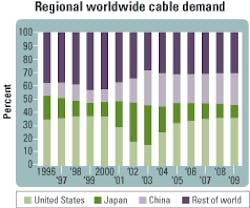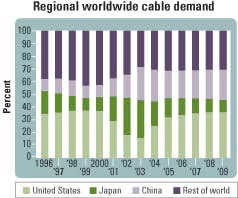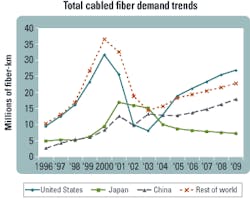FTTH a varied driver of cabled fiber demand
The United States, China, and Japan accounted for 65% of worldwide annual cabled fiber demand from 1996 through ’04, and are forecast to account for 69% of demand from 2005 through ’09. So looking toward the future, as these countries go, so goes the market. What explains the continuing dominance of these three countries within the world market? In other words, where is all this fiber being installed? One might think that fiber to the home (FTTH) would lead the way. If so, one would be only partially correct.
In the U.S. and China, increases in cabled fiber deployment during the last half of the 1990s and into 2001 were driven by long-distance applications. The U.S. situation was marked by significant over-construction. Backbone construction, however, has continued in China but is now focused on intra-provincial construction as well as new backbone construction by wireless operators.
Meanwhile, Japan already had begun to shift its network construction to the local application. From 1996 through 2004 NTT-and later the two restructured local companies, NTT East and NTT West-installed almost 25 million fiber-km in the “optical access network,” resulting in optical coverage exceeding 80% by last month. These access-network deployments account for 30% of singlemode cabled fiber installations in Japan over that period, and consisted of high-count feeder fiber cables. Total FTTX-related deployments are certainly higher since a number of service providers such as PoweredCom (an association of 10 utilities telecommunications subsidiaries), Tokyo Gas, and Usen Broadband have built access networks in Tokyo that parallel NTT’s network. Further, the optical access network discussed here only refers to feeder fiber installed from the central office to the demarcation point between underground and aerial infrastructure and doesn’t include the distribution and drop cables.Japan’s optical-access-network cabled fiber deployments slowed from 2003 to ’04 in NTT West and stayed flat in NTT East. With coverage rates at greater than 80%, a slowdown in network construction was likely due to a shift toward increasing FTTH subscription to generate revenues. The number of FTTH subscribers forecasted two years ago has been slow to develop, and there has been tremendous price competition among NTT and alternative broadband providers for broadband services. For example, NTT West now offers its 100-Mbit/sec FTTH service for ¥3,870 ($35) plus fees, down from ¥32,000 ($288) when it was first announced in December 2000. SoftbankBB introduced a Gigabit Ethernet PON 100-Mbit/sec service last October for a base monthly fee of ¥4,200 ($38). SoftbankBB’s total monthly charge, including all fees and taxes, is ¥7,234 ($65).
The price differences for high-bit-rate in Japan and the U.S. is significant. Verizon’s FiOS service includes three options: 5/2 Mbits/sec (downstream/upstream); 15/2 Mbits/sec, and 30/5 Mbits/sec. Verizon charges $199 per month for its 30-Mbit/sec service.
The optical coverage in Japan suggests that peak FTTH deployments are likely past. But FTTH-related deployments in the U.S. are set to grow dramatically; there will be 13% growth this year due primarily to the second year of FTTH-related deployments. The stronger U.S. demand related to FTTH means total cabled fiber demand in North America will grow by a compound annual growth rate of 15% from 2004 through ’09.
Stronger growth, especially related to last mile fiber installations, is encouraging. However, the prospect for widespread last mile deployment will be confined to the U.S. through ’09 and will require decades to reach fruition. That’s because while a number of FTTH trials are underway in Western Europe, for example, the incumbent service providers there will continue to focus on technological upgrades to DSL such as ADSL 2+, SDSL, and VDSL.
Meanwhile, although China is the world’s largest developing market and one of the top three countries for cabled fiber installations, the network investment and per capita income needed to make FTTH a nationwide reality remains years away. In February, ChinaDaily, a news organization, published 2004 data from the Beijing Municipal Bureau of Statistics. In a survey of 2,000 urban families in Beijing, the overall average per capita income was 15,600 yuan in 2004 ($1,900).
Deployments in other developing countries also will be minimal because of requirements to build-out backbone infrastructure and lower per capita income levels. Thus Asia-Pacific, as the largest regional customer for cabled fiber, will grow at a CAGR of only 3%. That means total global cabled fiber demand growth will be 7.5% through 2009, when KMI forecasts a total cabled fiber demand of 77.8 million fiber-km.
Patrick J. Fay is a senior analyst at KMI Research (Providence), a division of PennWell, publisher of Lightwave.


